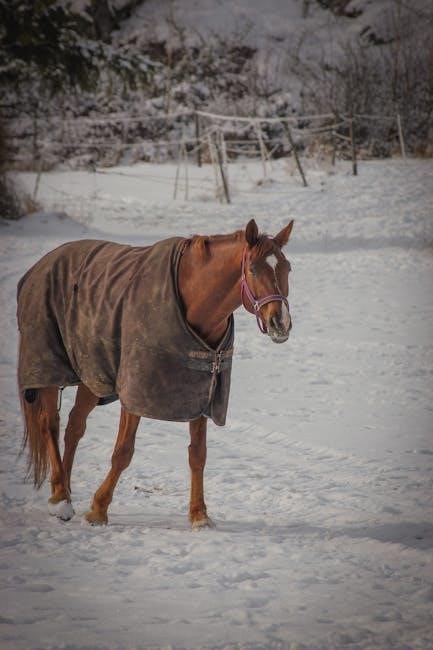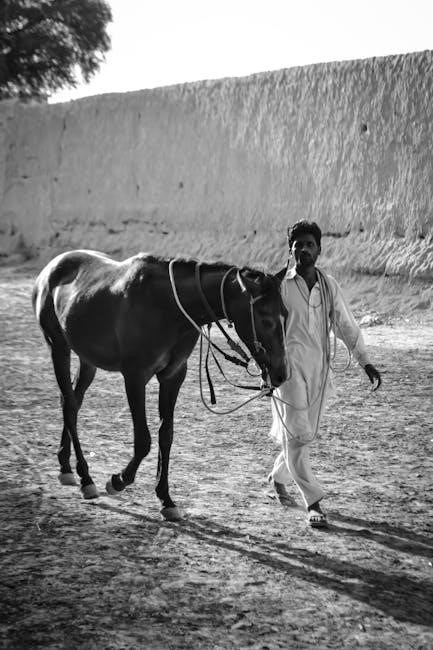A comprehensive guide to selecting the right horse blanket based on temperature, ensuring your horse stays comfortable without risking overblanketing. Learn how to choose the ideal weight for varying conditions.
Why Temperature Matters for Horse Blanketing
Temperature plays a critical role in horse blanketing, as it directly impacts a horse’s comfort and health. Horses are most comfortable in temperatures between 40°F and 80°F, but their needs vary depending on factors like coat length and activity level. Proper blanketing helps regulate body heat, preventing both chilling and overheating. Clipped horses, with shorter coats, require more insulation in cooler weather, while unclipped horses may need less. Incorrect blanketing can lead to discomfort, stress, or even health issues; Understanding temperature thresholds ensures your horse stays warm without risking overblanketing. Monitoring weather conditions and adjusting blankets accordingly is essential for maintaining your horse’s well-being. By tailoring your approach to temperature fluctuations, you can provide optimal care and ensure your horse remains comfortable year-round.

Understanding Blanket Weights and Temperature Ranges
Blanket weights are categorized by fill amount, with lightweight (0-100g), medium (150-250g), and heavyweight (300g+) options. Each weight corresponds to specific temperature ranges to ensure optimal comfort.
Lightweight Blankets (0-100g)
Lightweight blankets, typically weighing between 0-100g, are ideal for mild weather conditions or as a base layer. They provide minimal insulation, making them suitable for temperatures ranging from 40°F to 60°F for clipped horses and 30°F to 50°F for those with a natural coat. These blankets are perfect for spring and fall when the weather is cooler but not freezing. They help protect against wind and chill without causing overheating, ensuring your horse remains comfortable without excessive warmth. Lightweight options are also great for horses that are sensitive to heavier blankets or for those that spend most of their time indoors. Always consider your horse’s activity level and coat condition when choosing a lightweight blanket to ensure it meets their needs effectively.
Medium-Weight Blankets (150-250g)
Medium-weight blankets, ranging from 150-250g, offer balanced insulation for cooler temperatures. They are suitable for temperatures between 30°F and 50°F for clipped horses and 20°F to 40°F for those with a full coat. These blankets provide adequate warmth without being too heavy, making them ideal for transitioning seasons or moderate cold. They are versatile and can be used as a standalone layer or layered under heavier blankets in extreme cold; Medium-weight options are breathable, preventing overheating, and are designed to wick moisture away, keeping your horse dry and comfortable. They are particularly recommended for horses that spend time both indoors and outdoors, as they adapt well to varying conditions. Always consider your horse’s activity level and coat type when selecting a medium-weight blanket to ensure optimal comfort and protection. This range is a popular choice for many horse owners due to its adaptability.
Heavyweight Blankets (300g and Above)
Heavyweight blankets, with fills of 300g and above, are designed for extreme cold weather, typically below 30°F. These blankets provide maximum insulation and are ideal for clipped horses or those that spend most of their time outdoors in harsh conditions. They are durable and often feature waterproof and breathable materials to protect against snow and rain. While they offer superior warmth, they should be used cautiously to avoid overheating, especially in horses with a heavy natural coat. It’s essential to monitor your horse’s comfort and adjust as needed. Heavyweight blankets are a reliable choice for ensuring your horse stays warm during the coldest winter months, but they should only be used when temperatures drop significantly. Always consider your horse’s specific needs and the weather conditions before selecting a heavyweight option. Proper fitting is crucial to prevent discomfort and restrict movement.

Temperature Thresholds for Clipped vs. Unclipped Horses
Clipped horses may need blanketing at higher temperatures (50°F+), while unclipped horses can tolerate colder conditions. Always consider coat length and weather when deciding blanket weight and type.
Guidelines for Clipped Horses
Clipped horses require careful blanketing due to their shorter coats, which reduce natural insulation. For temperatures between 50°F and 60°F, a sheet or lightweight blanket (0-100g) is sufficient. As temperatures drop to 40°F-50°F, a light to medium-weight blanket (100g-150g) provides adequate warmth. Below 40°F, opt for a medium-weight blanket (150g-250g), and in extremely cold conditions (below 30°F), a heavyweight blanket (300g+) is essential. Always consider humidity, wind chill, and your horse’s activity level when choosing the blanket weight. Clipped horses may need blanketing at higher temperatures than unclipped horses, as their ability to retain heat is compromised. Monitor your horse’s comfort and adjust the blanket accordingly to prevent overblanketing, which can lead to sweating and discomfort. Proper blanketing ensures your clipped horse stays warm and healthy throughout the colder months.
Guidelines for Unclipped Horses
Unclipped horses have a natural winter coat, offering better insulation against cold temperatures. For temperatures between 40°F and 50°F, a lightweight blanket (0-100g) is typically sufficient. As temperatures drop to 30°F-40°F, a medium-weight blanket (150g-250g) provides additional warmth. Below 30°F, opt for a heavyweight blanket (300g+) to ensure your horse stays comfortable. Unclipped horses generally require less blanketing than clipped horses, as their coat traps warm air. However, wind, humidity, and rain can penetrate their coat, necessitating extra protection. Always observe your horse’s behavior and adjust the blanket weight accordingly. Avoid overblanketing, as it can cause sweating and discomfort. Proper blanketing for unclipped horses balances their natural insulation with external protection, ensuring they remain warm and healthy during colder weather.

Additional Factors Influencing Blanket Choice
Beyond temperature, consider humidity, wind chill, and your horse’s activity level. High humidity and wind can penetrate blankets, while active horses may need lighter options to prevent overheating.
Humidity and Wind Chill
Humidity and wind chill significantly impact your horse’s comfort. High humidity can make blankets feel heavier and less breathable, while wind chill lowers the perceived temperature, increasing the risk of cold stress. Even if the temperature seems mild, a wet blanket or windy conditions can quickly make your horse uncomfortable. Always check how your horse reacts to these factors. For example, in humid conditions, consider using a breathable blanket, and in windy weather, opt for a blanket with a secure fit to prevent it from shifting. Monitoring these factors ensures your horse stays warm and dry, regardless of the weather conditions. Regularly inspect the blanket’s condition to ensure it remains effective. Adjustments may be necessary to maintain your horse’s comfort and prevent overheating or chilling. Proper care and attention to these details are crucial for your horse’s well-being.
Horse’s Activity Level and Health
Your horse’s activity level and health play a crucial role in determining the appropriate blanket weight. Horses that are more active or have higher metabolisms may not need as heavy a blanket, as they generate more body heat. Conversely, horses with health issues, such as arthritis or those that are elderly, may require additional warmth for comfort. Always consider your horse’s individual needs, as some may be more sensitive to cold than others. Monitoring your horse’s behavior and physical condition can help you make informed decisions about blanketing. For example, a horse that is clipped and in regular work may need a lighter blanket compared to a horse with a full coat that is less active. Ensuring the right balance prevents overheating and ensures your horse stays comfortable and healthy throughout the season.
When Not to Blanket Your Horse
Avoid blanketing when temperatures exceed 50°F for clipped horses or 60°F for those with a natural coat. Overblanketing can lead to overheating and discomfort, especially in active or healthy horses.
Risks of Overblanketing
Overblanketing can lead to serious discomfort and health issues for horses. Excessive layers trap heat, causing overheating, sweating, and skin irritation. This can result in discomfort, restlessness, and even skin infections. Overblanketing may also suppress a horse’s natural ability to regulate its body temperature, making it reliant on blankets and less adaptable to changing conditions. In extreme cases, it can lead to heat stress, especially in warmer temperatures or for horses with high activity levels; Monitoring your horse’s behavior and adjusting blankets according to weather conditions is crucial to prevent these risks. Always ensure your horse has enough freedom of movement and doesn’t show signs of distress, such as excessive sweating or pacing. Proper blanket management is essential to keep your horse comfortable and healthy year-round.
Choosing the right horse blanket involves understanding temperature ranges, blanket weights, and your horse’s specific needs. By considering factors like humidity, wind chill, and your horse’s activity level, you can ensure their comfort and prevent health risks. Always monitor weather conditions and adjust blankets accordingly to avoid overheating or chilling. Remember, every horse is different, so tailor your approach based on their individual requirements. Proper blanketing not only protects your horse from harsh weather but also promotes their overall well-being. With this guide, you can make informed decisions to keep your horse cozy and healthy throughout the seasons.
